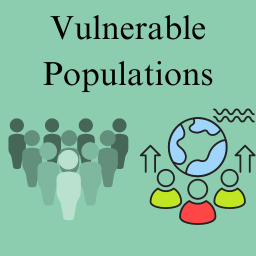Vulnerable Population and Health Issues


Whats are Vulnerable Populations
The combined term, VPs, yields an amalgamated description in reference to generalizing all people who are members of a defined class; who are worthy of being hurt, ignored or helped; and who are connected by action or process. Away referred to VPs as societal subgroups in the position of being hurt, ignored, and/or helped by others.
She claimed all members of human communities are potentially vulnerable. Flaskerud and Nyamanthi (2002) summarized typical VPs as women, children, and ethnic people of color, immigrants, homo sexual, the HIV infected, chemically addicted, mentally impaired, homeless, and elderly.
She contended that these groups have increased susceptibility to health adversities due to discrimination and marginalization ( Flaskerud &Nyamanthi ).
The legal definition of VPS is “those susceptible to coercive or undue influence; including children, prisoners, pregnant women, mentally disabled, and the economically or educationally disadvantaged” (Stone, TH, 2003).
Economically or educationally disadvantaged are considered invisible VPs. (Stone, T.H.). When coupled to subgroups, the appellation is doubly VPs (Moore, LW, & Miller, 1999).
Data of WHO and Health Issues Record
WHO Health for All highlights health data of subgroups; poverty and limited access to care (ATC) are primary contributors to poor health ( Hegavary , 2000). HP 2010 Goals to increase quality of health years and eliminate health disparities (HD) distinguishes improved ATC as one measure of goal attainment.
The NIH Mission focuses on the study of disease prevention and health promotion among diverse populations to reduce HD and improve ATC. The NINR Mission directs: eliminating substantial HD among different segments of the population, inclusive of certain ethnic groups; ATC; incidence of disease; length of life; and mortality rates.
Key Areas of Health Promotion
The American Nurse Association presents key areas for promoting health for all people. These include: policy development, influence public expectation, increase consumer demand for preventative health, and equitable ATC. These directives defend the relevance of VPS for nursing research (Edelman &Mandle ,2002).
The relevance of VPs to nursing research is critical ( Hinshaw , 2000). NIH has targeted studies that recognize certain ethnic groups' risk for disease, tensions mired in HD, lack of ATC, effects of environmental toxins, and increased risk for obesity.
In-depth and comparative studies which determine biological and behavioral factors impacting health are required to better understand VPs. Additionally, NIH seeks longitudinal research which evaluates effects of interventions of healthy behavioral change over time.
Two researchers have been instrumental in developing frameworks for vulnerable population research. In 1994, Aday (2001) developed a framework that identified VP's as significant contributors in ATC. Unique to the ATC Model are predictors for populations at risk. Predictors include demographics.
In 1998, Flaskerud (2002) developed VPS Conceptual Model that postulates interrelationships among resource availability, relative risk, and health status. The Flaskerud Model is unique because empirical indicators predict health status of populations.
Privacy Investigation
In 1999, NINR funded University of California, Los Angeles (UCLA) School of Nursing (SON), Center for Vulnerable Populations Research (CVPR), to unite scholars focused on HD among VPs. Primary investigators include: Deborah Koniak -Griffin, RN, EdD , Director of CVPR, Professor at UCLA-SON.
Her area of expertise is community based nursing to reduce risk and promote health of VPs, teens, young parents, and families. Adeline Nyamathi , PhD, ANP, is Associate Director of the CVPR and Associate Dean for Academic Programs at UCLASON.
Her areas of interests are homeless adults at risk for HIV, TB, and hepatitis; and VPs at risk for HIV in international settings. Jacquelyn Flaskerud , RN, PhD, is Professor Emeritus at UCLASON.
Her research interests are cultural beliefs and practices on prevention/ treatment of AIDS and mental illness, utilization of health services by VPs, participatory research (PR) methods, and methodological issues in working with culturally diverse populations.
Nancy Anderson, PhD, RN, is Professor Emeritus at UCLASON. Her areas of expertise are qualitative research methods, applications of PR methods, and development of culturally proficient research measures and interventions. For additional faculty participating in this project.
Three Cautionary Accounts
Fundamental to VPs research is issues of ethics involving human subjects (Mann, 2003). Three cautionary accounts were consistent in the literature.
First, consent from participants must be obtained post local ethics review boards because many members of VPs are minors, have cognitive problems, or are in custody of government.
Second, inclusion by self selection and/or referral may impact sample purity. Self selected participants may use the study as an opportunity to be less victimized by circumstance. Referrals might be made for the same reasons (Mann; Stone, TH, 2003). Watchirs (2002) provided an extensive review of methodologies measuring human rights which includes a review of current law for using VPS in PR.
Third, and an important ethical concern, is the prospect
of direct health related benefits. If a health problem is identified, an
intervention toward positive outcome must be offered (Stone, TH).
Vulnerable Populations as Social Group
VPs are social groups with increased risk of altered health. Researchers and law define these groups differently. Data are lacking to substantial which groups are at most risks. Financial deprivation and limited ATC are related.
Vulnerability is evidenced in worldwide trends of lower life expectancy, reduced ATC, and diminished quality of life. The UCLACVPR follows NIH directives to investigate VPs in terms of HD of minorities and those living in poverty.
CVPR investigators aim to advance knowledge about VPs, which includes
methods of PR which are subject to ethical scrutiny. In designing research with
respect to law and ethics, the substantive study of VPS by nursing has the
potential to influence world health and improve ATC for all.




Give your opinion if have any.